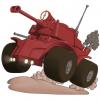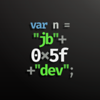In WWII there was a strange balance between tank armour and guns. Sides were examining what thickness of armour the opponent uses and install a gun just right to penetrate it but without excess. The idea was that if 70mm cannon could penetrate enemy armour the 85m cannon would be a waste (too heavy, too expensive for no additional/marginal gain).
I'm thinking of using such system. The premise here is that the player observes (spys, combat reports) the enemy ships design (armour) and try to install guns able to counter these armours (just right guns, not the most powerfull possible). In addition it would encourage the player to have different forces vs different enemies (vs enemy that tend to build ships with high armour a high penetration gun fleet would be used, while a cheaper/faster fleet would be used vs enemies that have low armour).
Post anything related, I just want to talk about it :)
How it could be done:
The assumption here is that combat is automated & abstracted, AI captains fire at each other following just general orders of the player.
Variables:
* ships have Armour rating, it's two numbers like "Armour:5-3" (since armour can be of different thickness in front/sides/rear)
* weapons have Penetration rating, it's one number like "Penetration:4"
* weapons have Damage rating, it's independent from Penetration (but usualy high damage guns would also have high penetration)
* weapons have FireRate rating, basicly smaller guns with low penetration & damage can fire more often (these don't necessarily have to be cheaper)
Mechanic:
* each turn/battle phase there is a roll on current Armour of the target (between max/min), it's affected by maneuverability (more maneuverable ships can position themselves better than heavy one and assure they face them front, where their armour is the thickest), tactical skills of the captain (can outsmart enemy captain and position the ship better), level of targetting computers (able to target more vulnerable parts of enemy armour)
* if the Penetration is higher or equal to Armour of the target the hit deals full damage, if it's lower it deals half damage, if it's less than 1/2 of the Armour it deals no damage at all
Ships composition:
* this system dictates that each ships should have at least two gun types, the main gun useful for at least scratching high armour targets and smaller/point defence guns that fire fast but are effective against low armour targets only
Other idea:
Quite similar, but ther Armour has three numbers (front/sides/back) like "Armour:8-3-2" or "Armour:5-2-2". It's less intuitive but more in the mood (everyone understands that whatever vehicle it is it's more armoured on front, less on sides and the least on the rear). Althrough, maybe it's not so intuitive for space ships?










